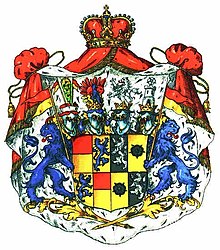Solms-Baruth

Solms-Baruth was a Lower Lusatian class lordship of the House of Solms , which existed from the 16th century until 1945.
history
In 1596, Count Otto zu Solms-Laubach (1550–1612), who owned the Sonnewalde ( Niederlausitz ), among other things , bought the Baruth from the Trebbin governor Hans von Buch, who had acquired it from the Wettins . After the split of the Counts of Solms-Laubach, who resided in Baruth / Mark , in 1615, the class was named Solms-Baruth , after the town of Baruth / Mark, which received Magdeburg city charter shortly before the start of the Thirty Years War in 1616 . The Baruth Castle was built after the 1,671th The family later rounded off the rule around Schloss Golßen and Schloss Casel (in Kasel-Golzig ).
The caste domination belonged to 1815 to Saxony and fell after the Congress of Vienna in Prussia . The Prussian representative at this congress was Prince Karl August von Hardenberg and his assistant was Count zu Solms-Sonnewalde. The Baruth estate, which was owned by the Princely Solms-Baruth family until 1945, comprised fourteen villages and around 15,000 hectares of land used for agriculture and forestry in the former Jüterbog-Luckenwalde district , later the Zossen district and now the Teltow-Fläming district in the former Potsdam district , today the state of Brandenburg .
The city of Baruth is located on the highway from Berlin , via Wünsdorf , Golßen , Lübbenau to Dresden . Today's most interesting sight from the history of Solms-Baruther is the Baruther Glashütte museum village . The princely house of Solms-Baruth was expropriated without compensation in 1946 .

In 1767, Count Hans Christian zu Solms-Baruth acquired the Lower Silesian Klitschdorf Palace , which subsequently became the main residence. Friedrich Hermann zu Solms-Baruth got involved in the Kreisau district and was arrested in 1944, his property in Baruth and Klitschdorf confiscated. He survived the end of the war and emigrated to South West Africa. Due to the seizure by the National Socialists, his son Friedrich (1926-2006) received partial areas of 3680 hectares in Baruth in 2003 through a settlement with the Federal Ministry of Finance. He also bought Baruth Castle back from the Baruth Commune. His younger son managed the property and carried out renovation work, but the older son, who lived in South Africa, inherited it and immediately sold it again.
Casel Castle
Noblemen
- Otto, Count of Solms-Sonnenwalde (1596–1612)
- Friedrich Albert, Count of Solms-Sonnenwalde (1612–1615)
- Johann Georg II. (1615–1632), Count of Solms-Baruth in Wildenfels
- Johann Georg III. (1632–1690), Count of Solms-Baruth
- Friedrich Sigismund I (1632–1696)
- Friedrich Sigismund II. (1696–1737)
- Friedrich Gottlob Heinrich (1737–1787)
- Friedrich Carl Leopold (1787–1801)
- Friedrich Heinrich Ludwig (1801–1879)
- Friedrich I (1879–1904), Prince of Solms-Baruth 1888
- Friedrich II. (1904–1920), politician, chamberlain and member of the Prussian manor house.
- Friedrich (1920–1951), resistance fighter of July 20, 1944
Important personalities from the house of Solms-Baruth
- Feodora zu Solms-Baruth (1920–2006), track and field athlete
- Johann Georg III. zu Solms-Baruth (1630–1690), sacred song writer
- Friedrich zu Solms-Baruth (1853–1920) (1853–1920), German politician and Chamberlain
- Friedrich zu Solms-Baruth (1886–1951) (1886–1951), German nobleman and resistance fighter of July 20, 1944
- Friedrich-Hans Graf zu Solms-Baruth (1926–2006), member of the German high nobility
Web links
- http://www.royaltyguide.nl/families/solms/solmsbaruth1.htm
- http://www.royaltyguide.nl/families/solms/solmsbaruth2.htm
- Castle in Baruth / Mark


